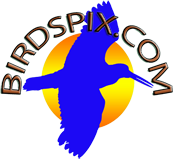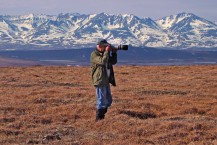September 30 – October 2: On September 29 Dan Logan and I journeyed to Bar Harbor for Maine Audubon’s annual pelagic outing to the Bay of Fundy. The weather forecast for the Sunday boat trip was dismal, and as luck would have it, for once the forecast unfortunately turned out to be accurate, with almost constant rain varying between drizzle and torrential downpour. Nonetheless, ninety participants (from as far away as 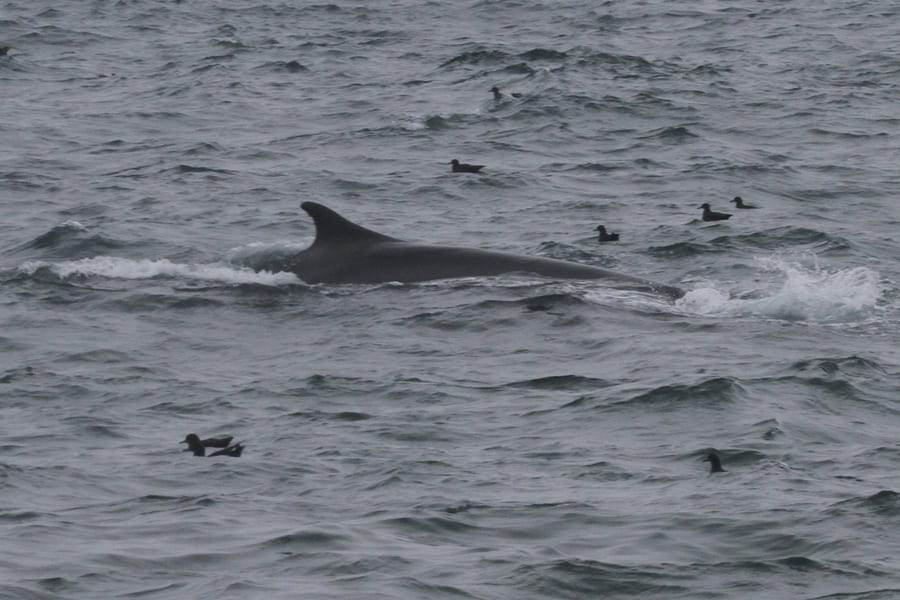 California) plus several guides set out at 6 AM on the 100+ foot jet-powered hydrofoil regularly used for whale watching. At a speed of 32 knots we were able to get out as far as 75 miles to a large concentration of both seabirds and whales, which even included Finbacks (the world’s second largest animal after the Blue Whale).
California) plus several guides set out at 6 AM on the 100+ foot jet-powered hydrofoil regularly used for whale watching. At a speed of 32 knots we were able to get out as far as 75 miles to a large concentration of both seabirds and whales, which even included Finbacks (the world’s second largest animal after the Blue Whale).
 I was hoping to photograph Atlantic Puffins, hopefully some Razorbills, and with luck perhaps a Leach’s Storm-Petrel (which are more scattered in these waters than the usually more numerous Wilson’s Storm-Petrels). In
I was hoping to photograph Atlantic Puffins, hopefully some Razorbills, and with luck perhaps a Leach’s Storm-Petrel (which are more scattered in these waters than the usually more numerous Wilson’s Storm-Petrels). In  summertime Puffins and Razorbills nest on the rocky shores of islands off the Maine coast, but by this time of year they have left their nesting areas and are found only at sea. The Puffins retain their orange bills, but have lost their harlequin white faces which now appear a dusky gray. On this day we did see perhaps two dozen swimming Puffins, with several quite close to the boat, but there were only two
summertime Puffins and Razorbills nest on the rocky shores of islands off the Maine coast, but by this time of year they have left their nesting areas and are found only at sea. The Puffins retain their orange bills, but have lost their harlequin white faces which now appear a dusky gray. On this day we did see perhaps two dozen swimming Puffins, with several quite close to the boat, but there were only two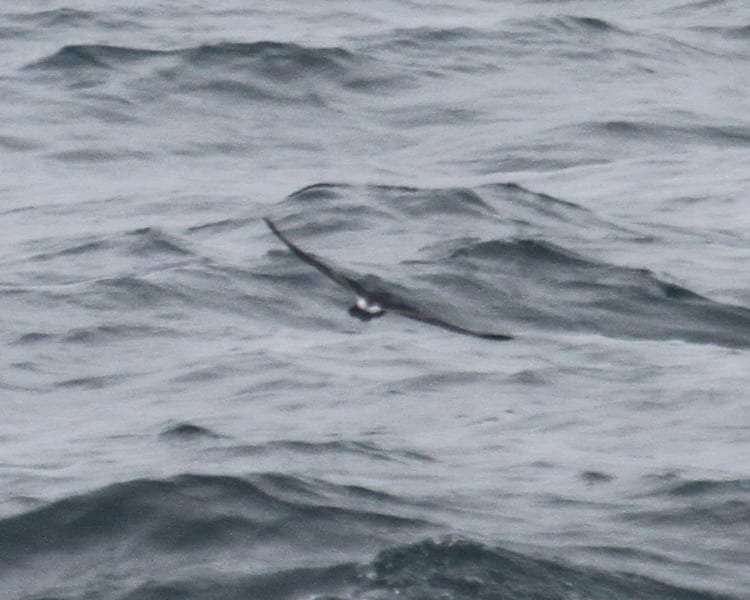 distant sightings of Razorbills, totalling just seven individuals. Three Leach’s Storm-Petrels (easy to identify by their dancing, prancing behavior on the water) were sighted, but very far away with photographs good enough only for sight record documentation.
distant sightings of Razorbills, totalling just seven individuals. Three Leach’s Storm-Petrels (easy to identify by their dancing, prancing behavior on the water) were sighted, but very far away with photographs good enough only for sight record documentation.
The most common species were the many hundreds of both 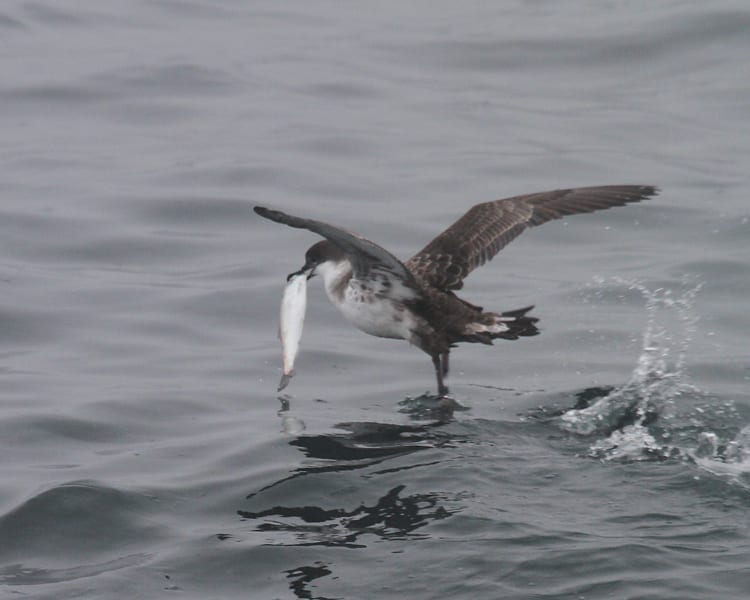 Sooty and Great Shearwaters, as well as the expected numerous Herring and Great Black-backed Gulls. There were several Northern Gannets and Common Eiders, three Manx Shearwaters, two Black-legged Kittiwakes, a Lesser
Sooty and Great Shearwaters, as well as the expected numerous Herring and Great Black-backed Gulls. There were several Northern Gannets and Common Eiders, three Manx Shearwaters, two Black-legged Kittiwakes, a Lesser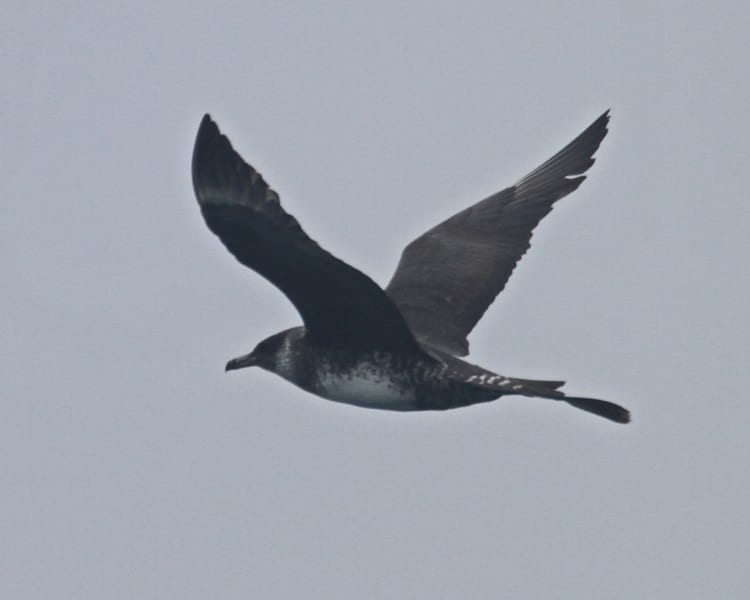 Black-backed Gull, two Great Cormorants, twenty Pomarine Jaegers, one Parasitic Jaeger, three Northern Fulmars, several small groups of Red-necked Phalaropes, two Red Phalaropes, and one Surf Scoter. A few
Black-backed Gull, two Great Cormorants, twenty Pomarine Jaegers, one Parasitic Jaeger, three Northern Fulmars, several small groups of Red-necked Phalaropes, two Red Phalaropes, and one Surf Scoter. A few 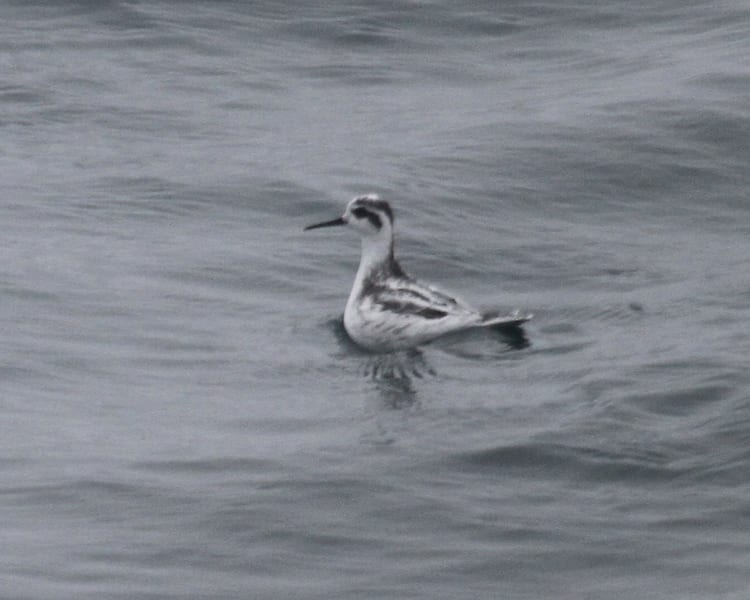 decent photos were obtained despite photography opportunity being hampered most of the time by the rain. The boat docked back in Bar Harbor right on schedule at 2 PM, and we immediately headed north to Millinocket, the closest town to Baxter State Park, where our main target species for the next day was Spruce Grouse.
decent photos were obtained despite photography opportunity being hampered most of the time by the rain. The boat docked back in Bar Harbor right on schedule at 2 PM, and we immediately headed north to Millinocket, the closest town to Baxter State Park, where our main target species for the next day was Spruce Grouse.
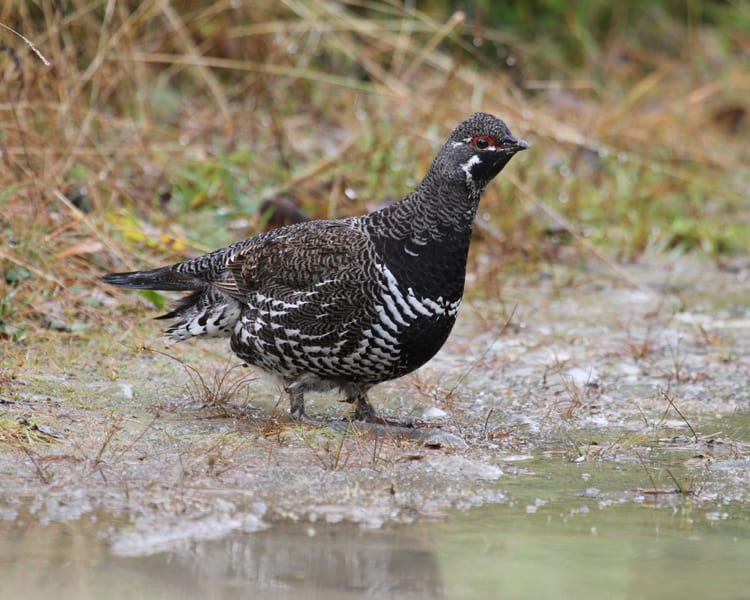 Bob Duschene of Maine Audubon met us at our motel at 6 AM on October 1 to get an early start, but rather than travel into Baxter State Park itself, where the road is dark and heavily canopied and the woodland edge too close to the road for good viewing perspective, Bob chose the area, just west of Baxter, off Telos Road, where both Spruce Grouse
Bob Duschene of Maine Audubon met us at our motel at 6 AM on October 1 to get an early start, but rather than travel into Baxter State Park itself, where the road is dark and heavily canopied and the woodland edge too close to the road for good viewing perspective, Bob chose the area, just west of Baxter, off Telos Road, where both Spruce Grouse 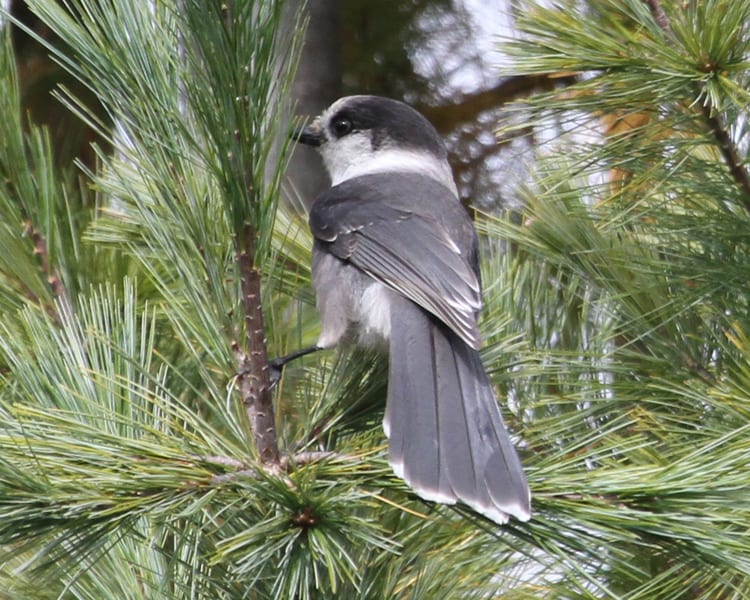 and Ruffed Grouse can be more readily spotted from a distance when they venture out of the woods onto the surface of the sparsely travelled unpaved logging roads. It rained off and on all morning, but during the course of working the roads for grouse, we also found ten Gray Jays in several small groups, numerous
and Ruffed Grouse can be more readily spotted from a distance when they venture out of the woods onto the surface of the sparsely travelled unpaved logging roads. It rained off and on all morning, but during the course of working the roads for grouse, we also found ten Gray Jays in several small groups, numerous 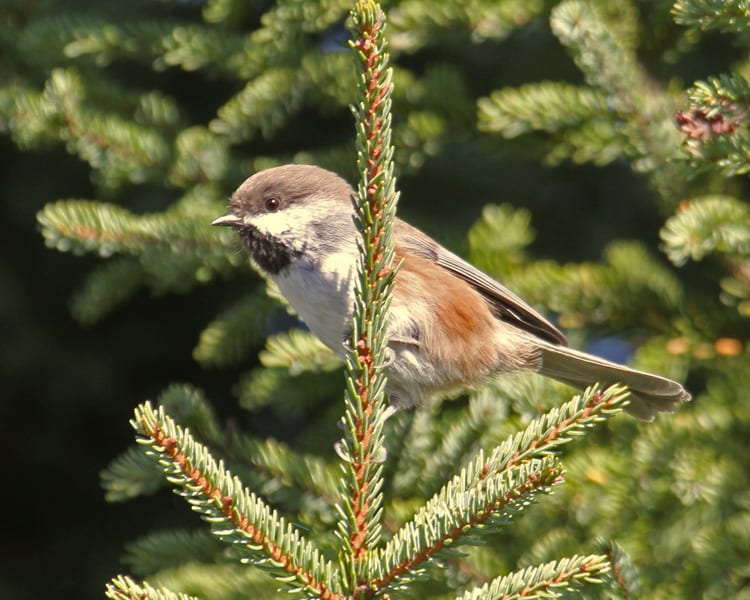 Common Ravens, several Boreal Chickadees, a few lingering Palm Warblers, and a Red-breasted Nuthatch. Near Nesowadnehunk Campground, we stopped at a spot where Bob had on other days seen both Black-backed and American Three-toed Woodpeckers. While getting one brief glimpse of the Three-toed, but no Black-backed, we were amazed to suddenly become
Common Ravens, several Boreal Chickadees, a few lingering Palm Warblers, and a Red-breasted Nuthatch. Near Nesowadnehunk Campground, we stopped at a spot where Bob had on other days seen both Black-backed and American Three-toed Woodpeckers. While getting one brief glimpse of the Three-toed, but no Black-backed, we were amazed to suddenly become 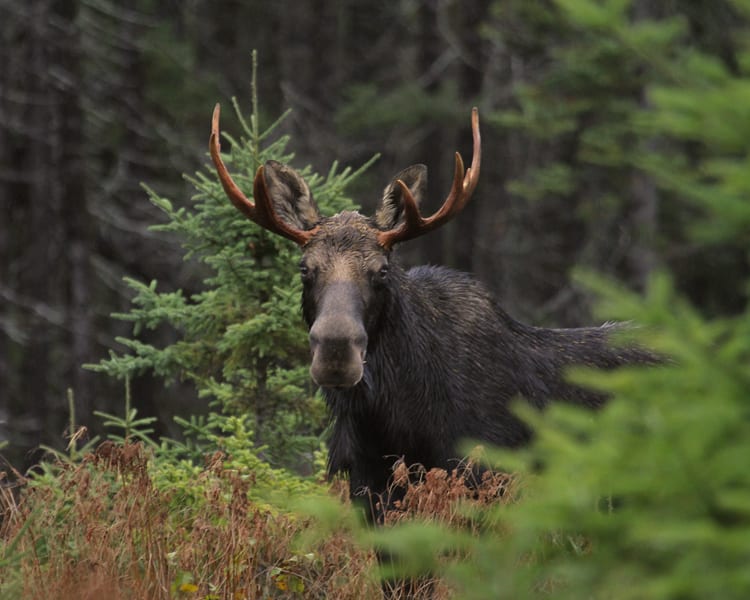 aware of a bull moose watching us from less than twenty yards away. It had never made a sound, and there was no telling how long it had been standing there.
aware of a bull moose watching us from less than twenty yards away. It had never made a sound, and there was no telling how long it had been standing there.
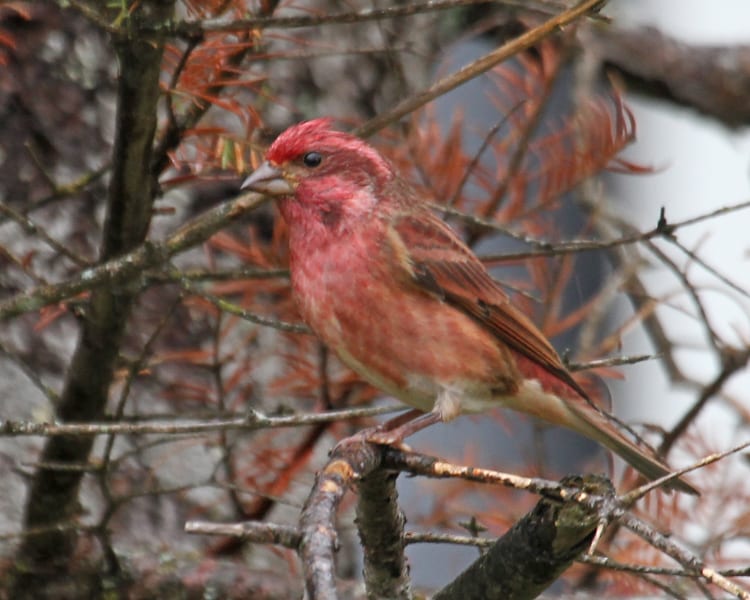 We then checked out the feeders at the campground, where there were good numbers of Purple Finches and Pine Siskins, as well as a mixed flock of White-crowned, White-throated, and a few Chipping Sparrows. The pond there had a single female Common Goldeneye. This seems to be an especially good autumn for both Purple Finches and Pine Siskins in Connecticut as well.
We then checked out the feeders at the campground, where there were good numbers of Purple Finches and Pine Siskins, as well as a mixed flock of White-crowned, White-throated, and a few Chipping Sparrows. The pond there had a single female Common Goldeneye. This seems to be an especially good autumn for both Purple Finches and Pine Siskins in Connecticut as well.
Between Spruce Grouse and Ruffed Grouse, Spruce is the scarcer and harder to find, but are very tame and allow very close approach, while Ruffed Grouse are skittish and spook very easily. One good explanation for this is that Spruce Grouse are protected by law, while Ruffed Grouse are huntable and have therefore become wary by virtue of being shot at all the time. The large birding group Bob had taken out just two days earlier did not see a single Spruce Grouse all day, and we also were becoming less optimistic after seeing no grouse all morning, but after the rain finally began to taper off we actually wound up spotting fourteen Spruce Grouse in five different places, including a family group of five. Ironically however, we failed to find a single Ruffed Grouse. To add insult to injury, when we mentioned to two hunters who happened by in a pickup truck that we were hoping to 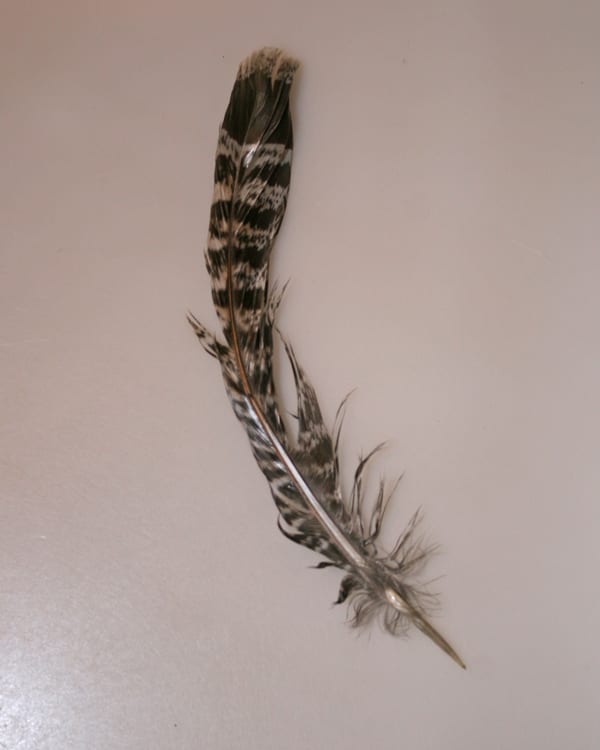 find a Ruffed Grouse to photograph, one of them reached into the bed of his truck, held up a freshly killed bird, and then plucked a tail feather and handed it to me!
find a Ruffed Grouse to photograph, one of them reached into the bed of his truck, held up a freshly killed bird, and then plucked a tail feather and handed it to me!
Because the weather report for the following day was for sunny skies, we opted to stay over one more night – both to allow ourselves until 1 PM to look for Ruffed Grouse again since neither of us yet had a single picture of one (except for that tail feather…), but also to get the foliage in decent sunlight. As we made the right turn off Telos Road onto the road leading back to Nesowadnehunk Campground, sure enough there was a Ruffed Grouse by the roadside within the very first 200 yards, but we were not yet in slow search mode, going too fast, spotted it too late, and before we could stop the car it had scurried back into the woods never to be seen again and, Murphy’s Law fully in force, we never did find another one.
A bonus of this Maine trip was that it was perfect peak foliage time in the north woods, and the colors were spectacular, especially the vivid reds. We stopped at a bridge to photograph Mount Katahdin and met a hiker who was just completing six-months hiking the entire Appalachian Trail from its end point in Georgia to where it begins at the top of Mount Katahdin. So the trip was memorable for photos of four new species of birds (many more for Dan, who is newer to bird photography), two moose, magnificent foliage, and the emergence of a new nemesis species for me – the common Ruffed Grouse, which (other than the Delaware Blue Hen) remains the only state bird (Pennsylvania) of which I still have no photos.
